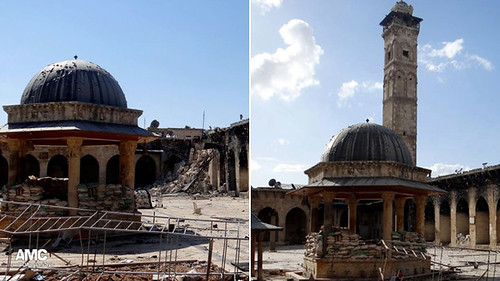聯合國教科文組織世界遺產委員會決定將六處敘利亞世界遺產遺址列入「危險級」名單中,以提醒世人關注該國持續內戰所帶來的其他風險。
列入危險名單的作用,是打算動員所有可能的支援,來保護那些國際社會所認定、具有人類整體代表性、以及特殊價值的資產。
值得擔心的相關文化古蹟有:大馬士革古城、巴爾米拉(Palmyra)遺址、布斯拉(Bosra)古城、阿勒頗(Aleppo)古城、武士城堡(Crac des Chevaliers)、薩利薩拉赫·埃爾(Qal'at Salah El-Din)以及北敘利亞古老村莊。
在敘利亞北方阿勒頗古城,建造於12世紀的倭馬亞大清真寺,在2012年10月間就已被激烈的戰火嚴重損壞,其尖塔更於今年4月24日遭戰火摧毀,委員會對此關心度升高。
聯合國教科文組織早在1986年就將阿勒頗古城列入世界遺產名冊中,表彰其「稀有並有著正宗的阿拉伯建築風格」,且其見證了此寨城的文化、社會和科技發展。為敘利亞六個世界遺產之一。
本月初,保加利亞籍的聯合國教科文組織總幹事伊琳娜‧博科娃(Irina Bokova)表達他「對敘利亞之文化遺產的安全性嚴重地關切。」「我呼籲立即停止破壞古蹟,以示尊重敘利亞人的信仰和傳統。」
「數千年的多樣性信仰構成了敘利亞最珍貴的寶藏之一。」 博科娃表示,:「正如我先前針對各個國家遺產破壞的呼籲所強調,破壞文化遺產是不光彩的,因為他們攻擊了具有特色的公有財產。」「我們都關心世界文化遺產之保護。近年來爆發的衝突告訴我們,文化遺產能作為一個強而有用的工具來加強相互的理解、社會的凝聚力,最終,達到世界和平。」
她提議派出教科文組織的專家,「在如此動盪局勢下,儘最大程度評估文物古蹟損壞狀況、制定和實施保全策略。」教科文組織正在協調國際力量,以遏制敘利亞文物的非法販運,「敘利亞人的無可取代的文化遺產遭破壞,是全人類的損失。」
索羅門群島 世界自然遺產古蹟也列瀕危
此遺址占倫內爾(Rennell )島南部1/3範圍,這個島是西太平洋索羅門群島中最南端的島嶼。
世界遺產委員會認定,伐木威脅東倫內爾島的全球性價值,即便伐木活動並不在遺產的核心地帶,委員會仍要求該國主管機關提供伐木衝擊評估。
此遺產場址面積為37,000公頃,大部份是森林,在1998年列入「世界遺產名錄」。
這個島是世界上最大的珊瑚環礁,其茂密的森林樹冠平均有20米高。森林是環礁的核心,是公認的科學研究天然實驗室。
該場址的顯著特點是Tegano湖,此湖是環礁的潟湖,約有15,000公頃大,是太平洋最大的島湖。有著許多粗糙的石灰岩小島,湖的鹹水港發現很多本地特有種,包括海蛇。周圍的喀斯特地形(水蝕石灰岩地形),有原生森林的茂密植被。在自然狀態下保存下來的,森林具有豐富的生物多樣性,有很多特有物種,包括4種陸地鳥類和9種亞種的水鳥類,蝙蝠和七種陸地蝸牛。
世界遺產委員會表示,因氣候變化引起的海平面上升,造成Tegano湖的水位和鹽度升高,對於生長在低窪地區的植物有著不利影響。
該場址的所有範圍,包括島嶼內陸和海洋珊瑚礁,都是索羅門群島憲法所公認的傳統領域。但傳統領域的所有者缺乏資金、能力和資源有限,無法充分保護和管理世界遺產的自然價值和資源。
世界遺產委員會的21名成員目前在金邊開第37屆會議。會議在6月27日結束於吳哥。
he UNESCO World Heritage Committee has decided to place the six World Heritage sites of the Syrian Arab Republic on the List of World Heritage in Danger to draw attention to the risks posed by the conflict raging in the country.
The danger listing is intended to mobilize all possible support to safeguard the properties which are recognized by the international community as being of outstanding universal value for humanity as a whole.
The sites concerned are all cultural sites: the Ancient City of Damascus: Site of Palmyra; Ancient City of Bosra; Ancient City of Aleppo; Crac des Chevaliers and Qal'at Salah El-Din; and the Ancient Villages of Northern Syria.
The Committee's concern was elevated by the conflict on April 24 that destroyed the minaret of the 12th century Umayyad Mosque in the northern Syrian city of Aleppo. The mosque had already been badly damaged by fire during heavy fighting in the ancient city in October 2012.
The Ancient City of Aleppo was inscribed on UNESCO's World Heritage List in 1986, in recognition of its "rare and authentic Arab architectural styles" and its testimony to the walled city's cultural, social, and technological development. It is one of six Syrian World Heritage sites.
UNESCO Director General Irina Bokova of Bulgaria expressed her "grave concern for the safety of Syria's cultural heritage," earlier this month.
"I call upon the perpetrators to cease the destruction immediately and demonstrate respect for the beliefs and traditions of all Syrians," Bokova said.
"The religious diversity that has characterized Syria over millennia constitutes one of the country's most precious treasures," said Bokova. "As I have stressed in my previous appeals regarding the destruction of heritage properties in various countries, attacks against cultural heritage are insidious as they strike the very identity of communities."
"Protecting the heritage of the world's cultures concerns us all. As demonstrated in a number of conflict situations that have erupted in recent years," she said, "cultural heritage can serve as a powerful tool to reinforce mutual understanding, social cohesion and ultimately, world peace."
Bokova offered UNESCO's technical expertise "to assess the damage to heritage sites, prepare and implement safeguarding strategies as well as to restore the damaged cultural monuments to the extent allowed by the volatile security situation."
UNESCO is coordinating international efforts to curb the illicit trafficking of Syrian cultural objects, Bokova said, adding, "The destruction of the irreplaceable cultural heritage of the Syrian people is a loss for all of humanity."
A World Heritage Natural site in the Solomon Islands was also placed on List of World Heritage in Danger.
The site makes up the southern third of Rennell Island, the southernmost island in the Solomon Island group in the western Pacific.
The World Heritage Committee determined that logging is threatening the outstanding universal value of East Rennell, and asked the national authorities to provide an impact assessment study of the logging, although it is taking place outside the site's core area.
Forests cover most of the land area of the 37,000-hectare site, which was inscribed on the World Heritage List in 1998.
It is the largest raised coral atoll in the world and its dense forest has a canopy averaging 20 meters in height. The forest is an essential component of the atoll, which is considered to be a true natural laboratory for scientific study.
A prominent feature of the property is Lake Tegano, the former lagoon of the atoll, which at 15,000 hectares is the largest lake in the insular Pacific. With its many rugged limestone islets, the lake's brackish waters harbour numerous native species found nowhere else including a sea snake. The surrounding karst terrain has a dense cover of indigenous forest. Remaining in its natural state, the forest has a rich biodiversity with many endemic species, including four species of land birds and nine subspecies of water birds, one bat and seven land snails.
Increasing water levels and salinity in Lake Tegano, induced by sea level rise due to climate change, are adversely affecting plant growth in low-lying areas, says the World Heritage Committee.
All land, islands and marine reefs within the property are under customary ownership, which is acknowledged in the Constitution of the Solomon Islands. But the ability of the traditional owners to adequately protect and manage the natural values and resources of the World Heritage site is limited by a lack of funding, capacity and resources.
The 21-member World Heritage Committee is currently holding its 37th session in Phnom Penh. The session will close in Angkor on June 27.
※ 全文及圖片詳見:ENS







